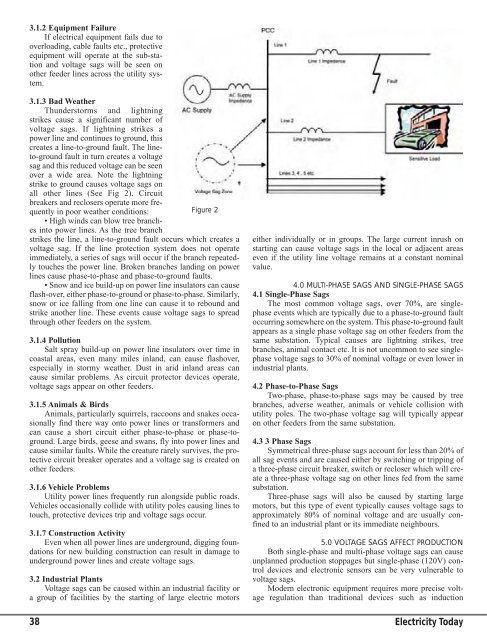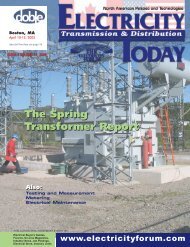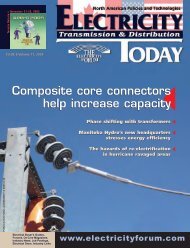in this issue - Electricity Today Magazine
in this issue - Electricity Today Magazine
in this issue - Electricity Today Magazine
Create successful ePaper yourself
Turn your PDF publications into a flip-book with our unique Google optimized e-Paper software.
3.1.2 Equipment Failure<br />
If electrical equipment fails due to<br />
overload<strong>in</strong>g, cable faults etc., protective<br />
equipment will operate at the sub-station<br />
and voltage sags will be seen on<br />
other feeder l<strong>in</strong>es across the utility system.<br />
3.1.3 Bad Weather<br />
Thunderstorms and lightn<strong>in</strong>g<br />
strikes cause a significant number of<br />
voltage sags. If lightn<strong>in</strong>g strikes a<br />
power l<strong>in</strong>e and cont<strong>in</strong>ues to ground, <strong>this</strong><br />
creates a l<strong>in</strong>e-to-ground fault. The l<strong>in</strong>eto-ground<br />
fault <strong>in</strong> turn creates a voltage<br />
sag and <strong>this</strong> reduced voltage can be seen<br />
over a wide area. Note the lightn<strong>in</strong>g<br />
strike to ground causes voltage sags on<br />
all other l<strong>in</strong>es (See Fig 2). Circuit<br />
breakers and reclosers operate more frequently<br />
<strong>in</strong> poor weather conditions:<br />
• High w<strong>in</strong>ds can blow tree branches<br />
<strong>in</strong>to power l<strong>in</strong>es. As the tree branch<br />
Figure 2<br />
strikes the l<strong>in</strong>e, a l<strong>in</strong>e-to-ground fault occurs which creates a<br />
voltage sag. If the l<strong>in</strong>e protection system does not operate<br />
immediately, a series of sags will occur if the branch repeatedly<br />
touches the power l<strong>in</strong>e. Broken branches land<strong>in</strong>g on power<br />
l<strong>in</strong>es cause phase-to-phase and phase-to-ground faults.<br />
• Snow and ice build-up on power l<strong>in</strong>e <strong>in</strong>sulators can cause<br />
flash-over, either phase-to-ground or phase-to-phase. Similarly,<br />
snow or ice fall<strong>in</strong>g from one l<strong>in</strong>e can cause it to rebound and<br />
strike another l<strong>in</strong>e. These events cause voltage sags to spread<br />
through other feeders on the system.<br />
3.1.4 Pollution<br />
Salt spray build-up on power l<strong>in</strong>e <strong>in</strong>sulators over time <strong>in</strong><br />
coastal areas, even many miles <strong>in</strong>land, can cause flashover,<br />
especially <strong>in</strong> stormy weather. Dust <strong>in</strong> arid <strong>in</strong>land areas can<br />
cause similar problems. As circuit protector devices operate,<br />
voltage sags appear on other feeders.<br />
3.1.5 Animals & Birds<br />
Animals, particularly squirrels, raccoons and snakes occasionally<br />
f<strong>in</strong>d there way onto power l<strong>in</strong>es or transformers and<br />
can cause a short circuit either phase-to-phase or phase-toground.<br />
Large birds, geese and swans, fly <strong>in</strong>to power l<strong>in</strong>es and<br />
cause similar faults. While the creature rarely survives, the protective<br />
circuit breaker operates and a voltage sag is created on<br />
other feeders.<br />
3.1.6 Vehicle Problems<br />
Utility power l<strong>in</strong>es frequently run alongside public roads.<br />
Vehicles occasionally collide with utility poles caus<strong>in</strong>g l<strong>in</strong>es to<br />
touch, protective devices trip and voltage sags occur.<br />
3.1.7 Construction Activity<br />
Even when all power l<strong>in</strong>es are underground, digg<strong>in</strong>g foundations<br />
for new build<strong>in</strong>g construction can result <strong>in</strong> damage to<br />
underground power l<strong>in</strong>es and create voltage sags.<br />
3.2 Industrial Plants<br />
Voltage sags can be caused with<strong>in</strong> an <strong>in</strong>dustrial facility or<br />
a group of facilities by the start<strong>in</strong>g of large electric motors<br />
38<br />
either <strong>in</strong>dividually or <strong>in</strong> groups. The large current <strong>in</strong>rush on<br />
start<strong>in</strong>g can cause voltage sags <strong>in</strong> the local or adjacent areas<br />
even if the utility l<strong>in</strong>e voltage rema<strong>in</strong>s at a constant nom<strong>in</strong>al<br />
value.<br />
4.0 MULTI-PHASE SAGS AND SINGLE-PHASE SAGS<br />
4.1 S<strong>in</strong>gle-Phase Sags<br />
The most common voltage sags, over 70%, are s<strong>in</strong>glephase<br />
events which are typically due to a phase-to-ground fault<br />
occurr<strong>in</strong>g somewhere on the system. This phase-to-ground fault<br />
appears as a s<strong>in</strong>gle phase voltage sag on other feeders from the<br />
same substation. Typical causes are lightn<strong>in</strong>g strikes, tree<br />
branches, animal contact etc. It is not uncommon to see s<strong>in</strong>glephase<br />
voltage sags to 30% of nom<strong>in</strong>al voltage or even lower <strong>in</strong><br />
<strong>in</strong>dustrial plants.<br />
4.2 Phase-to-Phase Sags<br />
Two-phase, phase-to-phase sags may be caused by tree<br />
branches, adverse weather, animals or vehicle collision with<br />
utility poles. The two-phase voltage sag will typically appear<br />
on other feeders from the same substation.<br />
4.3 3 Phase Sags<br />
Symmetrical three-phase sags account for less than 20% of<br />
all sag events and are caused either by switch<strong>in</strong>g or tripp<strong>in</strong>g of<br />
a three-phase circuit breaker, switch or recloser which will create<br />
a three-phase voltage sag on other l<strong>in</strong>es fed from the same<br />
substation.<br />
Three-phase sags will also be caused by start<strong>in</strong>g large<br />
motors, but <strong>this</strong> type of event typically causes voltage sags to<br />
approximately 80% of nom<strong>in</strong>al voltage and are usually conf<strong>in</strong>ed<br />
to an <strong>in</strong>dustrial plant or its immediate neighbours.<br />
5.0 VOLTAGE SAGS AFFECT PRODUCTION<br />
Both s<strong>in</strong>gle-phase and multi-phase voltage sags can cause<br />
unplanned production stoppages but s<strong>in</strong>gle-phase (120V) control<br />
devices and electronic sensors can be very vulnerable to<br />
voltage sags.<br />
Modern electronic equipment requires more precise voltage<br />
regulation than traditional devices such as <strong>in</strong>duction<br />
<strong>Electricity</strong> <strong>Today</strong>












